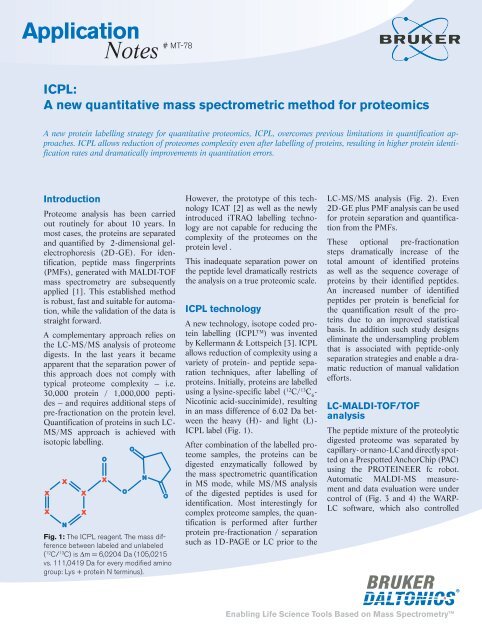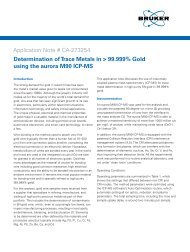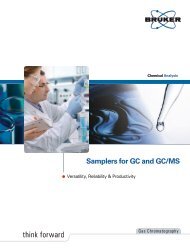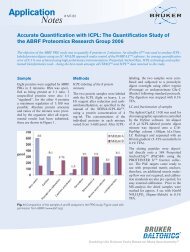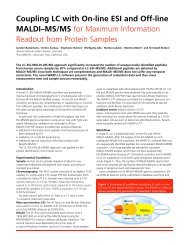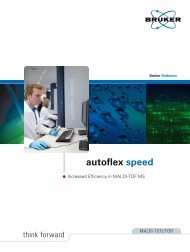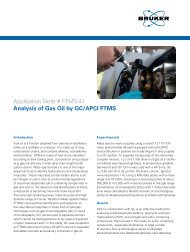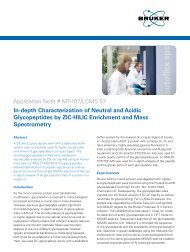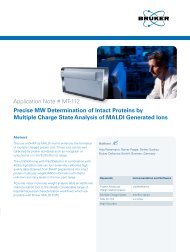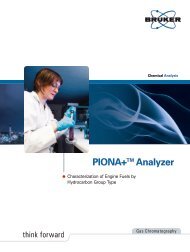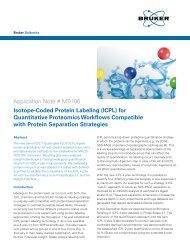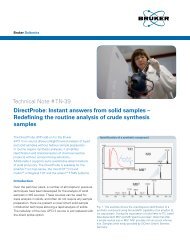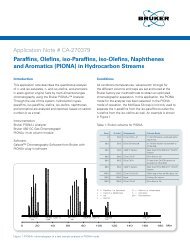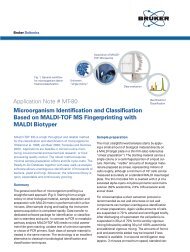Application Notes ICPL: A new quantitative mass ... - Bruker Daltonics
Application Notes ICPL: A new quantitative mass ... - Bruker Daltonics
Application Notes ICPL: A new quantitative mass ... - Bruker Daltonics
You also want an ePaper? Increase the reach of your titles
YUMPU automatically turns print PDFs into web optimized ePapers that Google loves.
<strong>Application</strong><br />
<strong>Notes</strong><br />
<strong>ICPL</strong>:<br />
A <strong>new</strong> <strong>quantitative</strong> <strong>mass</strong> spectrometric method for proteomics<br />
A <strong>new</strong> protein labelling strategy for <strong>quantitative</strong> proteomics, <strong>ICPL</strong>, overcomes previous limitations in quantification approaches.<br />
<strong>ICPL</strong> allows reduction of proteomes complexity even after labelling of proteins, resulting in higher protein identification<br />
rates and dramatically improvements in quantitation errors.<br />
Introduction<br />
Proteome analysis has been carried<br />
out routinely for about 10 years. In<br />
most cases, the proteins are separated<br />
and quantified by 2-dimensional gelelectrophoresis<br />
(2D-GE). For identification,<br />
peptide <strong>mass</strong> fingerprints<br />
(PMFs), generated with MALDI-TOF<br />
<strong>mass</strong> spectrometry are subsequently<br />
applied [1]. This established method<br />
is robust, fast and suitable for automation,<br />
while the validation of the data is<br />
straight forward.<br />
A complementary approach relies on<br />
the LC-MS/MS analysis of proteome<br />
digests. In the last years it became<br />
apparent that the separation power of<br />
this approach does not comply with<br />
typical proteome complexity – i.e.<br />
30,000 protein / 1,000,000 peptides<br />
– and requires additional steps of<br />
pre-fractionation on the protein level.<br />
Quantification of proteins in such LC-<br />
MS/MS approach is achieved with<br />
isotopic labelling.<br />
�<br />
�<br />
�<br />
�<br />
�<br />
�<br />
�<br />
�<br />
Fig. 1: The <strong>ICPL</strong> reagent. The <strong>mass</strong> difference<br />
between labeled and unlabeled<br />
( 12 C/ 13 C) is Δm = 6,0204 Da (105,0215<br />
vs. 111,0419 Da for every modifi ed amino<br />
group: Lys + protein N terminus).<br />
��<br />
�<br />
�<br />
# MT-78<br />
�<br />
However, the prototype of this technology<br />
ICAT [2] as well as the <strong>new</strong>ly<br />
introduced iTRAQ labelling technology<br />
are not capable for reducing the<br />
complexity of the proteomes on the<br />
protein level .<br />
This inadequate separation power on<br />
the peptide level dramatically restricts<br />
the analysis on a true proteomic scale.<br />
<strong>ICPL</strong> technology<br />
A <strong>new</strong> technology, isotope coded protein<br />
labelling (<strong>ICPL</strong>TM ) was invented<br />
by Kellermann & Lottspeich [3]. <strong>ICPL</strong><br />
allows reduction of complexity using a<br />
variety of protein- and peptide separation<br />
techniques, after labelling of<br />
proteins. Initially, proteins are labelled<br />
using a lysine-specific label ( 12C/ 13C - 6<br />
Nicotinic acid-succinimide), resulting<br />
in an <strong>mass</strong> difference of 6.02 Da between<br />
the heavy (H)- and light (L)-<br />
<strong>ICPL</strong> label (Fig. 1).<br />
After combination of the labelled proteome<br />
samples, the proteins can be<br />
digested enzymatically followed by<br />
the <strong>mass</strong> spectrometric quantification<br />
in MS mode, while MS/MS analysis<br />
of the digested peptides is used for<br />
identification. Most interestingly for<br />
complex proteome samples, the quantification<br />
is performed after further<br />
protein pre-fractionation / separation<br />
such as 1D-PAGE or LC prior to the<br />
LC-MS/MS analysis (Fig. 2). Even<br />
2D-GE plus PMF analysis can be used<br />
for protein separation and quantification<br />
from the PMFs.<br />
These optional pre-fractionation<br />
steps dramatically increase of the<br />
total amount of identified proteins<br />
as well as the sequence coverage of<br />
proteins by their identified peptides.<br />
An increased number of identified<br />
peptides per protein is beneficial for<br />
the quantification result of the proteins<br />
due to an improved statistical<br />
basis. In addition such study designs<br />
eliminate the undersampling problem<br />
that is associated with peptide-only<br />
separation strategies and enable a dramatic<br />
reduction of manual validation<br />
efforts.<br />
LC-MALDI-TOF/TOF<br />
analysis<br />
The peptide mixture of the proteolytic<br />
digested proteome was separated by<br />
capillary- or nano-LC and directly spotted<br />
on a Prespotted AnchorChip (PAC)<br />
using the PROTEINEER fc robot.<br />
Automatic MALDI-MS measurement<br />
and data evaluation were under<br />
control of (Fig. 3 and 4) the WARP-<br />
LC software, which also controlled<br />
Enabling Life Science Tools Based on Mass Spectrometry
�������� �������� �������� �������� �������� �������� �������� ��������� ��������� ��������� ��������� ��������� ��������� ���������<br />
�������� �������� �������� �������� �������� �������� �������� �������� �������� �������� �������� �� �� �� �� �� �� � ��������� ��������� ��������� ��������� ��������� ��������� ��������� ��������� ��������� ��������� ��������� ��������� ��������� ��������� ��������� ��������� ��������� ��������� ��������� ��������� ��������� ��������� ��������� ���������<br />
��������<br />
����� � ����� �<br />
���� ������<br />
���������� ���<br />
�����������������<br />
��� ����� ������ ��������<br />
���� ��� ����� ������������<br />
�������������<br />
�� ��� ������� �����<br />
�������������<br />
�� ��� ������� �����<br />
�������<br />
��� ��� ��� ���<br />
���� ������������<br />
�������������� ����<br />
��� ��� ��� ��� ��� ��� ���<br />
���� ���� ���� ���� ���� ���� ���� ���� ���� ���� ���� ���� ���� ����� ����� ����� ����� ����� ����� ����� ����� ����� ����� ����� ����� �����<br />
��� ��� ��� ��� ��� ��� ��� ��� ��� ��� ���<br />
��� ����� ������ ��������<br />
���� ��� ����� ������������<br />
�� �� �� �� ��� ��� ��� ��� ��� ��� ��� ���<br />
��������� ���������<br />
��� ��� ���<br />
�������������� �������<br />
the automatic selection of peptides<br />
for further MS/MS analysis. <strong>ICPL</strong>labelled<br />
peptides were preferentially<br />
selected for MS/MS analysis based<br />
on their H/L ratio, dramatically reducing<br />
the number of MS/MS spectra<br />
and processing time.<br />
In contrast to LC-ESI, MALDI-MS<br />
spectra are acquired without any interruption<br />
by MS/MS acquisition and<br />
thus don‘t miss out on the provided<br />
peptides eluting from the LC-column.<br />
MS/MS analyses of all relevant peptides<br />
are performed off line well after<br />
the LC separation.<br />
The Prespotted AnchorChips (PACs)<br />
that we use in these setups are microstructured<br />
disposable plastic chips<br />
enabling exact drying of the peptide<br />
fractions on defined sample spots [4].<br />
These disposable MALDI targets allow<br />
to immobilize whole chromatograms<br />
for considerable time (3 months to 1<br />
year is easily possible) which renders<br />
them an ideal tool for further re-analysis<br />
and archiving of multiple LC-runs<br />
eliminating the need to repeat the LCseparation<br />
for fraction re-analysis.<br />
The Quality of <strong>ICPL</strong><br />
Quantifi cation<br />
A lysate from E. coli was divided into<br />
two identical aliquots and spiked with<br />
additional proteins from different species<br />
and in various concentrations,<br />
followed by either labelling with the<br />
light or the heavy <strong>ICPL</strong>-label (<strong>ICPL</strong>kit,<br />
<strong>Bruker</strong> <strong>Daltonics</strong>). Subsequently,<br />
both samples were mixed, digested<br />
with trypsin and analysed via LC-<br />
MALDI (Fig. 2). The E. coli proteins<br />
continuously show an intensity ratio of<br />
H/L = 1:1 of the <strong>ICPL</strong>-labelled peptides.<br />
The spiked ovalbumin provided<br />
a regulation of H/L = 0.53 (theoretical:<br />
0.5). In general all quantification<br />
errors in <strong>ICPL</strong>-experiments were in<br />
the 5 % range, if more than 4 clearly<br />
identified pairs of peptides were determined.<br />
However, for identification of<br />
Fig. 2: Schematic representation of the<br />
<strong>ICPL</strong> work fl ow. Proteins from different<br />
sources are labelled with the heavy (H) or<br />
the light (L) form of the <strong>ICPL</strong> reagent. After<br />
merging the samples and an optional protein<br />
fractionation, analysis is performed by<br />
proteolytic digestion, LC-separation, MSquantifi<br />
cation and MS/MS indentifi cation.
Fig. 3: WARP-LC Survey View of a LC-MALDI run with <strong>ICPL</strong>-labelled E. coli lysat. The retention time (min.) vs. the peptide <strong>mass</strong> (m/z) is<br />
shown. Some peptide pairs, used for quantitation are shown. E. coli proteins are in a ratio of 1 : 1. Multiple labelled peptides (e. g. 1 to 3<br />
lysine groups per peptide) are responsible for the distance of pairs of 6, 12, or 18 Da. The two peptides shown to be regulated in a ratio<br />
of 1 : 2 derive from the labelled ovalbumin.<br />
a protein even two pairs are already<br />
sufficient. In case of ovalbumin, a<br />
quantification error of 6% was determined.<br />
If only two or three pairs of<br />
peptides are given, outliers can not be<br />
identified on solid statistical grounds,<br />
seriously affecting the quality of the<br />
analysis as well as the validation of<br />
data.<br />
Thus, the pre-fractionation on the protein<br />
level allows reducing the sample<br />
complexity prior to the LC-MALDI<br />
analyses and to achieve a higher<br />
number of peptide pairs per protein.<br />
This effect can be demonstrated very<br />
impressively with the 2D-GE-PMF<br />
analysis of <strong>ICPL</strong>-labelled proteomes.<br />
Here, a quantification error well within<br />
the 5%-range was achieved with a protein-sequence-coverage<br />
of 30-80%<br />
[3].<br />
� ������<br />
� ������<br />
�� ��<br />
���� ���� ���� ���� ��� ���<br />
� ������<br />
� �� �� ��<br />
���<br />
���<br />
���� ���� ���� ���� ���� ���� ��� ��� ���� ���� ���� ���� ���� ���� ���� ���� ��� ���<br />
Fig. 4: Summarization of the LC-MALDI analysis shown in Fig. 2. E. coli proteins show a<br />
H/L ratio of 1; ovalbumin a H/L ratio of 0.5.
Further promising features<br />
of the <strong>ICPL</strong>-technology<br />
In contrast to technologies on the basis<br />
of peptide labelling (e.g. iTRAQ),<br />
<strong>ICPL</strong> enables the detection of protein<br />
isoforms, posttranslational modifications<br />
and variants of protein-splicing<br />
that can only be distinguished if at<br />
least one of the separation parameters<br />
of the workflow is based on molecular<br />
properties of intact proteins, such as<br />
their molecular weight or their isoelectric<br />
point.<br />
Furthermore, the signal intensities of<br />
labelled peptides is 10-20 times higher<br />
than those of unlabelled ones and thus<br />
simplifies MS/MS fragmentation.<br />
During the MALDI process, the nicotinic-acids<br />
of the <strong>ICPL</strong>-label serve as<br />
MALDI-matrix and thus ease the ionisation<br />
of the peptides.<br />
References<br />
1. Suckau D, Resemann A,<br />
Schuerenberg M, Hufnagel P,<br />
Franzen J, Holle A (2003):<br />
A novel MALDI LIFT-TOF/TOF<br />
<strong>mass</strong> spectrometer for proteomics.<br />
Anal Bioanal Chem. 376:<br />
952-65.<br />
2. Gygi SP, Rist B, Gerber SA,<br />
Turecek F, Gelb MH, Aebersold<br />
R. (1999): Quantitative analysis<br />
of complex protein mixtures using<br />
isotope-coded affinity tags. Nat<br />
Biotechnol. 17: 994-9.<br />
3. Schmidt A, Kellermann J, Lottspeich<br />
F (2005): A novel strategy<br />
for <strong>quantitative</strong> proteomics using<br />
isotope-coded protein labels.<br />
Proteomics 5: 4-15.<br />
4. Schuerenberg M, Luebbert C,<br />
Eickhoff H, Kalkum M, Lehrach<br />
H, Nordhoff E (2000): Prestructured<br />
MALDI-MS sample supports.<br />
Anal Chem. 72: 3436-42.<br />
www.bdal.de<br />
www.bdal.com<br />
Authors:<br />
Detlev Suckau1 , Stephanie Hahner1 ,<br />
Sven Brand1 , Wolfgang Jabs1 ,<br />
Martin Schürenberg1 und Thomas M.<br />
Halder2 1: <strong>Bruker</strong> Daltonik GmbH, Bremen,<br />
Germany<br />
2: TopLab GmbH, Martinsried,<br />
Germany<br />
Ordering Info for the <strong>ICPL</strong>-kit:<br />
Product Cat. No. Size<br />
SERVA <strong>ICPL</strong>TM-Kit #234017 1 Kit (2 x 6 samples)<br />
The SERVA <strong>ICPL</strong>-Kit is worldwide available through <strong>Bruker</strong> <strong>Daltonics</strong> care:<br />
www.bdal.de/care.<br />
The <strong>ICPL</strong> technology is fully supported<br />
by <strong>Bruker</strong> <strong>Daltonics</strong> instruments and<br />
solutions in PROTEINEER-LC 1.1.<br />
<strong>ICPL</strong> is a trademark of TopLab GmbH.<br />
iTRAQ and ICAT are trademarks of Applera<br />
Corporation or its subsidiaries in the U.S. and/or certain<br />
other countries.<br />
<strong>Bruker</strong> Daltonik GmbH<br />
Bremen · Germany<br />
Phone +49 (421) 22 05-0<br />
Fax +49 (421) 22 05-104<br />
E-Mail sales@bdal.de<br />
See our website for worldwide sales and service contacts.<br />
<strong>Bruker</strong> <strong>Daltonics</strong> Inc.<br />
Billerica, MA · USA<br />
Phone +1 (978) 663-36 60<br />
Fax +1 (978) 667-59 93<br />
E-Mail ms-sales@bdal.com<br />
© <strong>Bruker</strong> <strong>Daltonics</strong> 03-2006, MT-78


